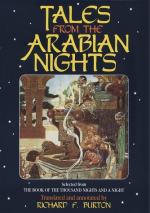[FN#159] Arab. “Raih yasir,” peasant’s language.
[FN#160] Arab. Ka’ah, the apodyterium or undressing room upon which the vestibule of the Hammam opens. See the plan in Lane’s M. E. chaps. xvi. The Kar’ah is now usually called “Maslakh” = stripping-room.
[FN#161] Arab. “Hammam-hu” = went through all the operations of the Hammam, scraping, kneading, soaping, wiping and so forth.
[FN#162] For this aphrodisiac see vol. vi. 60. The subject of aphrodisiacs in the East would fill a small library: almost every medical treatise ends in a long disquisition upon fortifiers, provocatives’ etc. We may briefly divide them into three great classes. The first is the medicinal, which may be either external or internal. The second is the mechanical, such as scarification’ flagellation, and the application of insects as practiced by certain savage races. There is a venerable Joe Miller of an old Brahmin whose young wife always insisted, each time before he possessed her, upon his being stung by a bee in certain parts. The third is magical superstitious and so forth
[FN#163] This may sound exaggerated to English ears, but a petty Indian Prince, such as the Gaikwar, or Rajah of Baroda, would be preceded in state processions by several led horses all whose housings and saddles were gold studded with diamonds. The sight made one’s mouth water.
[FN#164] i.e. the ’Arab al-’Arba; for which see vols. i. 112; v. 101.
[FN#165] Arab. “Al-Kandil al-’ajib:” here its magical virtues are specified and remove many apparent improbabilities from the tale.
[FN#166] This was the highest of honours. At Abyssinian Harar even the Grandees were compelled to dismount at the door of the royal “compound.” See my “First Footsteps in East Africa,” p. 296.
[FN#167] “The right hand” seems to me a European touch in Galland’s translation, leur chef mit Aladdin a sa droite. Amongst Moslems the great man sits in the sinistral corner of the Divan as seen from the door, so the place of honour is to his left.
[FN#168] Arab. “Musika,” classically “Musiki” ={Greek}: the Pers. form is Musikar; and the Arab. equivalent is Al-Lahn. In the H. V. the King made a signal and straightway drums (dhol) and trumpets (trafir) and all manner wedding instruments struck up on every side.
[FN#169] Arab. Marmar Sumaki=porphyry of which ancient Egypt supplied the finest specimens. I found a vein of it in the Anti-Libanus. Strange to say, the quarries which produced the far-famed giallo antico, verd’ antico (serpentine limestone) and rosso antico (mostly a porphyry) worked by the old Nilotes, are now unknown to us.
[FN#170] i.e. velvets with gold embroidery: see vol. viii. 201.
[FN#171] The Arabic says, “There was a kiosque with four-and-twenty alcoves (Liwan, for which see vols. iv. 71, vi. 347) all builded of emerald, etc., and one remained with the kiosque (kushk) unfinished.” I adopt Galland’s reading salon a vingt-quatre croisees which are mentioned in the Arab. text towards the end of the tale, and thus avoid the confusion between kiosque and window. In the H. V. there is a domed belvedere (barah-dari-i-gumbaz-dar), four-sided, with six doors on each front (i. e. twenty-four), and all studded with diamonds, etc.




